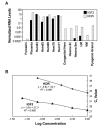Genomic imprinting of IGF2 is maintained in infantile hemangioma despite its high level of expression
- PMID: 15706404
- PMCID: PMC1431374
- DOI: 10.2119/2004-00045.Bischoff
Genomic imprinting of IGF2 is maintained in infantile hemangioma despite its high level of expression
Abstract
Hemangioma, the most common tumor of infancy, is characterized by rapid growth and slow regression. Increased mRNA expression of insulin-like growth factor 2 (IGF2) has been detected in the proliferating phase by cDNA microarray analysis, but the underlying mechanism causing the increase remains unknown. Here, using quantitative real-time polymerase chain reaction (PCR) and immunohistochemistry, we show that IGF2 is highly expressed in both proliferating and involuting phase hemangioma, but is not detectable in other vascular lesions such as pyogenic granuloma, venous malformation, lymphatic malformation, or in normal infant skin. Loss of imprinting of the Igf2 gene has been associated with IGF2 overexpression in a variety of childhood tumors. To determine if loss of imprinting and consequent bi-allelic expression might contribute to the increased expression of IGF2, we examined the genomic imprinting status of Igf2 in 48 individual hemangiomas. We determined allele-specific Igf2 expression using reverse transcriptase-PCR combined with analysis of an Apa I-sensitive restriction fragment length polymorphism. Similar to heterozygous normal skin controls, all 15 informative hemangiomas showed uniform mono-allelic expression of Igf2. Therefore, loss of imprinting is not involved in the increased expression of IGF2 in infantile hemangioma.
Figures




Similar articles
-
Loss of imprinting of insulin-like growth factor-II (IGF2) gene in distinguishing specific biologic subtypes of Wilms tumor.J Natl Cancer Inst. 2001 Nov 21;93(22):1698-703. doi: 10.1093/jnci/93.22.1698. J Natl Cancer Inst. 2001. PMID: 11717330
-
Imprinting and expression of insulin-like growth factor-II and H19 in normal breast tissue and breast tumor.J Clin Endocrinol Metab. 1996 Apr;81(4):1607-12. doi: 10.1210/jcem.81.4.8636375. J Clin Endocrinol Metab. 1996. PMID: 8636375
-
Relaxation of insulin-like growth factor 2 gene imprinting in esophageal cancer.Int J Cancer. 1996 Nov 15;68(4):441-6. doi: 10.1002/(SICI)1097-0215(19961115)68:4<441::AID-IJC7>3.0.CO;2-0. Int J Cancer. 1996. PMID: 8945613
-
Pediatric adrenocortical tumors: molecular events leading to insulin-like growth factor II gene overexpression.J Clin Endocrinol Metab. 2000 May;85(5):2048-56. doi: 10.1210/jcem.85.5.6589. J Clin Endocrinol Metab. 2000. PMID: 10843195 Review.
-
IGF2: epigenetic regulation and role in development and disease.Cytokine Growth Factor Rev. 2008 Apr;19(2):111-20. doi: 10.1016/j.cytogfr.2008.01.005. Epub 2008 Mar 4. Cytokine Growth Factor Rev. 2008. PMID: 18308616 Free PMC article. Review.
Cited by
-
Rapidly involuting congenital haemangioma (RICH) of the liver.Pediatr Radiol. 2012 Mar;42(3):308-14. doi: 10.1007/s00247-011-2268-z. Pediatr Radiol. 2012. PMID: 22302317
-
Integrative meta-analysis identifies microRNA-regulated networks in infantile hemangioma.BMC Med Genet. 2016 Jan 15;17:4. doi: 10.1186/s12881-015-0262-2. BMC Med Genet. 2016. PMID: 26772808 Free PMC article.
-
IGF-2 and FLT-1/VEGF-R1 mRNA levels reveal distinctions and similarities between congenital and common infantile hemangioma.Pediatr Res. 2008 Mar;63(3):263-7. doi: 10.1203/PDR.0b013e318163a243. Pediatr Res. 2008. PMID: 18287964 Free PMC article.
-
Endothelial progenitor cells from infantile hemangioma and umbilical cord blood display unique cellular responses to endostatin.Blood. 2006 Aug 1;108(3):915-21. doi: 10.1182/blood-2006-03-006478. Blood. 2006. PMID: 16861344 Free PMC article.
-
Evidence by molecular profiling for a placental origin of infantile hemangioma.Proc Natl Acad Sci U S A. 2005 Dec 27;102(52):19097-102. doi: 10.1073/pnas.0509579102. Epub 2005 Dec 19. Proc Natl Acad Sci U S A. 2005. PMID: 16365311 Free PMC article.
References
-
- Holmdahl K. Cutaneous hemangiomas in premature and mature infants. Acta Paediatr. 1955;44:370–9. - PubMed
-
- Mulliken JB. Cutaneous vascular anomalies. Semin Vasc Surg. 1993;6:204–18. - PubMed
-
- Yu Y, Flint AF, Mulliken JB, Wu JK, Bischoff J. Endothelial progenitor cells in infantile hemangioma. Blood. 2004;103:1373–5. - PubMed
Publication types
MeSH terms
Substances
Grants and funding
LinkOut - more resources
Full Text Sources
Other Literature Sources
Medical
Miscellaneous
